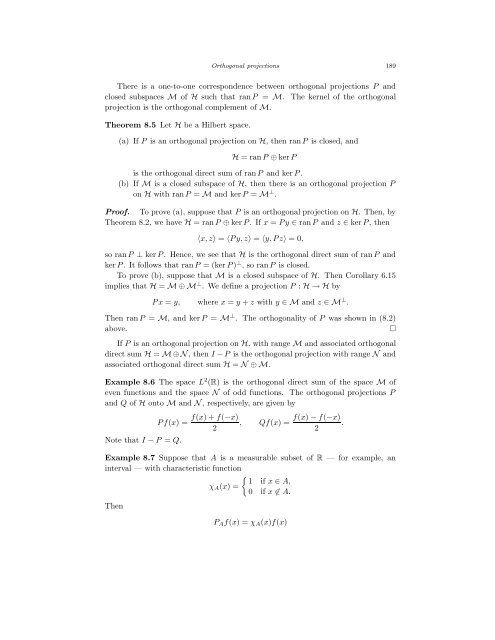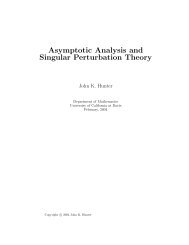Bounded Linear Operators on a Hilbert Space
Bounded Linear Operators on a Hilbert Space
Bounded Linear Operators on a Hilbert Space
Create successful ePaper yourself
Turn your PDF publications into a flip-book with our unique Google optimized e-Paper software.
Orthog<strong>on</strong>al projecti<strong>on</strong>s 189<br />
There is a <strong>on</strong>e-to-<strong>on</strong>e corresp<strong>on</strong>dence between orthog<strong>on</strong>al projecti<strong>on</strong>s P and<br />
closed subspaces M of H such that ran P = M. The kernel of the orthog<strong>on</strong>al<br />
projecti<strong>on</strong> is the orthog<strong>on</strong>al complement of M.<br />
Theorem 8.5 Let H be a <strong>Hilbert</strong> space.<br />
(a) If P is an orthog<strong>on</strong>al projecti<strong>on</strong> <strong>on</strong> H, then ran P is closed, and<br />
H = ran P ⊕ ker P<br />
is the orthog<strong>on</strong>al direct sum of ran P and ker P .<br />
(b) If M is a closed subspace of H, then there is an orthog<strong>on</strong>al projecti<strong>on</strong> P<br />
<strong>on</strong> H with ran P = M and ker P = M ⊥ .<br />
Proof. To prove (a), suppose that P is an orthog<strong>on</strong>al projecti<strong>on</strong> <strong>on</strong> H. Then, by<br />
Theorem 8.2, we have H = ran P ⊕ ker P . If x = P y ∈ ran P and z ∈ ker P , then<br />
〈x, z〉 = 〈P y, z〉 = 〈y, P z〉 = 0,<br />
so ran P ⊥ ker P . Hence, we see that H is the orthog<strong>on</strong>al direct sum of ran P and<br />
ker P . It follows that ran P = (ker P ) ⊥ , so ran P is closed.<br />
To prove (b), suppose that M is a closed subspace of H. Then Corollary 6.15<br />
implies that H = M ⊕ M ⊥ . We define a projecti<strong>on</strong> P : H → H by<br />
P x = y, where x = y + z with y ∈ M and z ∈ M ⊥ .<br />
Then ran P = M, and ker P = M ⊥ . The orthog<strong>on</strong>ality of P was shown in (8.2)<br />
above. <br />
If P is an orthog<strong>on</strong>al projecti<strong>on</strong> <strong>on</strong> H, with range M and associated orthog<strong>on</strong>al<br />
direct sum H = M ⊕ N , then I − P is the orthog<strong>on</strong>al projecti<strong>on</strong> with range N and<br />
associated orthog<strong>on</strong>al direct sum H = N ⊕ M.<br />
Example 8.6 The space L 2 (R) is the orthog<strong>on</strong>al direct sum of the space M of<br />
even functi<strong>on</strong>s and the space N of odd functi<strong>on</strong>s. The orthog<strong>on</strong>al projecti<strong>on</strong>s P<br />
and Q of H <strong>on</strong>to M and N , respectively, are given by<br />
P f(x) =<br />
Note that I − P = Q.<br />
f(x) + f(−x)<br />
, Qf(x) =<br />
2<br />
f(x) − f(−x)<br />
.<br />
2<br />
Example 8.7 Suppose that A is a measurable subset of R — for example, an<br />
interval — with characteristic functi<strong>on</strong><br />
<br />
1 if x ∈ A,<br />
χA(x) =<br />
0 if x ∈ A.<br />
Then<br />
PAf(x) = χA(x)f(x)
















